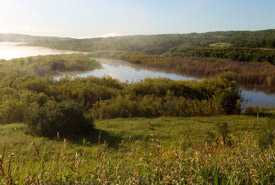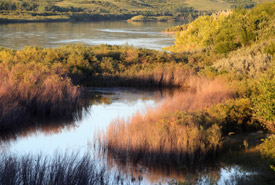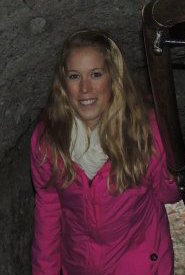Giving the grass a haircut

Maymont 5 property, SK (Photo by Mike Dembeck)
Last summer I gave the grass a haircut. It seemed like a strange idea, but I was excited to learn something new. As I arrived at the Nature Conservancy of Canada’s (NCC’s) Maymont 5 property in Saskatchewan, I was struck by the number of colours that surrounded me. Who knew that just plain old grassland would look so interesting? The grass was long, as it had not been grazed on that summer, and I watched as gentle waves of green and gold moved with the breeze over the gently rolling hills. The leaves of trembling aspen trees flickered in the background and birds sang in the tall shrubs. This sight alone was worth the three-and-a-half-hour drive from Regina.
I walked up the largest hill and sat down for a quick species identification and “haircut” lesson given by Kerry Hecker of the Canadian Wildlife Service (CWS)-Environment and Climate Change Canada, who has a restoration project in the Last Mountain Lake National Wildlife Area. NCC has partnered with CWS to sustainably harvest seeds from tall grasses to grow into plugs for future grassland restoration projects. So I grabbed a pair of scissors and started to give the grass a haircut.
It didn’t take long to find my target: plains rough fescue whose seed heads were ripe and ready for harvesting. They had turned a beautiful yellow colour and the seed heads were open slightly, indicating that the seeds would start falling soon.
Coming to my first patch of fescue, I clipped one of the stems and gently rubbed it back and forth on my lower lip. The tiny hairs on the stem felt very rough, telling me that I had identified the right grass. I started cutting small handfuls, being sure to leave about three to four inches of stem so that any slightly unripe seeds could use the left-over nutrients to ripen fully. I was careful to not take more than 30 per cent of each clump to ensure that enough seeds were left on the property for regeneration.

Maymont 5 property, SK (Photo by Mike Dembeck)
I carefully put each handful into a small cloth bag so that any seeds that fell off in transport were not lost. As I wandered around the property searching for fescue, I found myself getting lost in the methodical and relaxed pace of the day. I periodically looked up to survey the scene. Nuttall’s blister beetles, an insect that releases a fluid that causes blisters on skin when threatened, were everywhere as it was apparently mating season. I also saw lots of native plant species, including Hooker’s oat grass, pasture sage, three-flowered avens and Canada anemone. But my main focus that day was the plains rough fescue, and there was no shortage of it.
After having been “in the zone” for a while, I completely lost track of time. My co-workers alerted me that it was time to go, and I was sad to leave. Even though I realized that I was hot and tired and had a slightly sore back, I enjoyed every second of my time spent giving the fescue a haircut.
I don’t feel bad about taking the seeds from the property as they will be put to good use on grassland restoration projects. The seeds harvested from Maymont 5 will be used by Kerry on her grassland restoration projects and a portion will be given to NCC to use in restoration projects as well. Once the seeds have been removed from the stem and cleaned, they will be planted into plugs and then planted on NCC restoration projects and in the Last Mountain Lake Wildlife Area.
It’s a somewhat cathartic experience to lose yourself for a few hours in the rolling grasslands. Through my work with NCC, I am often reminded that relatively few people get the chance to get out into nature like I do. Everyone seems to be so busy, and unless you live in a rural area it can often be difficult to find time to go outside into the “wilderness.” This is why, when I visit the Maymont 5 property for work, I am reminded of how lucky I am to be able to experience and enjoy natural landscapes on a regular basis.
Maymont 5 is one of the Nature Conservancy of Canada’s properties featured in Nature Destinations, a program that invites you to take a journey through some of the greatest examples of our country’s natural areas and to connect with nature. Visit naturedestinations.ca.


